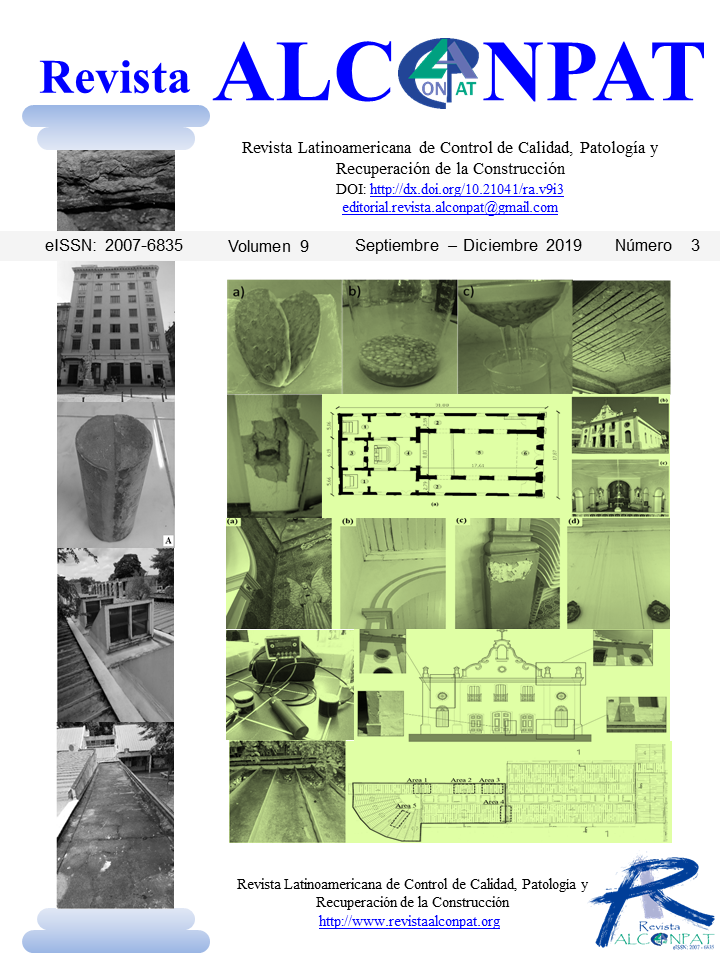Analysis of compost repair mortars by vinylic copolymer, PVA, and SBR
Abstract
This work has as its objective the development and analysis of compostable polymeric mortars using vinyl copolymer, PVA (polyvinyl acetate) and SBR (styrene-butadiene). Tests were carried out to determine the compressive and diametral compression tensile strengths. In addition, the adhesive strength between the repair and the concrete was determined by means of a diametral compression traction test. Among the materials tested, it was noticed that the material modified by SBR had the best performance, especially with respect to the adhesion to the concrete. In general, the results show that modified polystyrene hair hairs can be used to repair material.
Downloads
References
Alanazi, H., Yang, M., Zhang, D., Gao, Z. (2016), Bond strength of PCC pavement repairs using metakaolin-based geopolymer mortar. Cement and Concrete Composites. 65: 75-82. https://doi.org/10.1016/j.cemconcomp.2015.10.009
Associação Brasileira de Normas Técnicas. (2011) NBR 7222: Concreto e argamassa — Determinação da resistência à tração por compressão diametral de corpos de prova cilíndricos. Rio de Janeiro.
Espeche, A. D., León, J. (2011), Estimation of bond strength envelopes for old-to-new concrete interfaces based on a cylinder splitting test. Construction and Building Materials. 25: 1222–1235. https://doi.org/10.1016/j.conbuildmat.2010.09.032
Geiker, M. R. (2012), On the importance of execution for obtaining the designed durability of reinforced concrete structures: Construction of durable concrete structures. Materials and corrosión. 63:1114 -1118. https://doi.org/10.1002/maco.201206754
Helene, P. R. D. L. (1992), “Manual para reparo, reforço e proteção de Estruturas de Concreto”. PINI, São Paulo, Brasil.
Lukovic, M., Ye, G., Van Breugel, K. (2012), “Reliable concrete repair: A critical review”. 14th International Conference Structural Faults and Repair. Edinburgh, Scotland, UK.
Radhakrishnan, R., Syam Prakash, V., Prasad Varma Thampan, C. K. (2012), Performance of Styrene Butadiene Rubber as a Concrete Repair Material in tropical climate. International Journal of Advancements in Research & Technology, Volume 1, Issue 6, pp. 1-5, ISSN 2278-7763
Soufi, A., Mahieux, P. Y., Ait-Mokhtar, A. (2016), Influence of polymer proportion on transfer properties of repair mortars having equivalent water porosity. Materials and Structures. 49: 383–398. https://doi.org/10.1617/s11527-014-0504-3
Souza, V. C. M. D., Ripper, T. (1998), “Patologia, Recuperação e Reforço de Estruturas de Concreto”. PINI, São Paulo, Brasil.
Sprinkel, M. M., Ozyildirim, C. (2000), Evaluation of high performance concrete overlays placed on Route 60 over Lynnhaven Inlet in Virginia. Charlottesville, EUA.
Ueda, H., Tamai, Y., Kudo, T. (2011), Evaluation of the Durability of Cement-based Repair Materials. Railway Technical Research Institute. 52: 92-96. https://doi.org/10.2219/rtriqr.52.92
Ukrainczyk, N., Rogina, A. (2013), Styrene–butadiene latex modified calcium aluminate cement mortar. Cement & Concrete Composites. 41: 16–23. https://doi.org/10.1016/j.cemconcomp.2013.04.012
_______________________________
License in effect from September 2020
You are free to:
- Share — copy and redistribute the material in any medium or format for any purpose, even commercially.
- Adapt — remix, transform, and build upon the material for any purpose, even commercially.
- The licensor cannot revoke these freedoms as long as you follow the license terms.
Under the following terms:
- Attribution — You must give appropriate credit , provide a link to the license, and indicate if changes were made . You may do so in any reasonable manner, but not in any way that suggests the licensor endorses you or your use.
- No additional restrictions — You may not apply legal terms or technological measures that legally restrict others from doing anything the license permits.
Notices:
You do not have to comply with the license for elements of the material in the public domain or where your use is permitted by an applicable exception or limitation .
No warranties are given. The license may not give you all of the permissions necessary for your intended use. For example, other rights such as publicity, privacy, or moral rights may limit how you use the material.





















.png)














